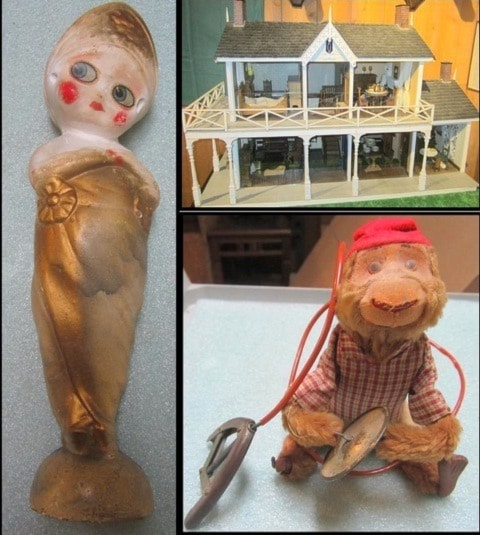This month we’re discussing toys in our artifact collection. We have a wide variety of toys mostly dating from the 1920s to 1980s. Among our collection are plenty of dolls, doll clothes, trucks and figurines but very few games. While the museum does not do artifact appraisals, you can use eBay as a tool to see how much money the toys you kept from your childhood are worth.
In our collection is a very special dollhouse that was commissioned by the museum and built by Ed Easton (2014.FIC.225). It was commissioned to hold a collection of over 75 pieces of dollhouse furnishings that were donated in 1983 by Betty Gibson. The dollhouse, on display inside Moss Cottage, is modelled after one of Victoria’s oldest estates called Wentworth Villa located at 1156 Fort Street. The villa was built in 1862 for Captain Henry Ella and had been used as an antique store since 1940. It was one of the first buildings to be added to the city’s heritage register and is representative of the Gothic Revival movement on the northwest coast. In 2012, an article in the Times Colonist stated that the house was up for conversion into condos but that a heritage conservation plan was pending.
The dollhouse furnishings belonged to the donor’s grandfather and were probably made in England. The collection includes a wide variety of items such as dishes, utensils, chairs, couches, cabinets, tables, beds, dolls, and even decorative pieces like sculptures and clocks. The items have incredible detail. For example a clock is made from gold-painted metal and has a copper cherub on the top playing a pipe (1983.056.006). The base of the clock is ornately decorated with curlicues (decorative twists and curls).
The museum has a large collection of various dolls, but the Kewpie doll is the most common. Kewpie dolls were an idea that started with illustrations, by Rose O’Neil, in the Ladies Home Journal. The editor of the journal wanted Rose to create illustrations of a cupid-like character to accompany a written piece. The Kewpie illustration became an instant hit and she soon began drawing for other publications. In 1912 Kewpie Kutouts, or paper dolls, were created. That same year, Rose was approached to develop a line of figurines and dolls. At first, the dolls were made from a high-fired German bisque and later, in the 1920s and 1930s, they were made from celluloid. It wasn’t until the mid-1900s that the dolls were created using plastic. We have one bisque Kewpie doll and several celluloid ones in our collection. Characteristics of a Kewpie doll are typically large wide eyes, pink-ish skin, large heads, short arms and legs that stand together. Many of the celluloid dolls have their arms attached by a string. There are many different themed Kewpie dolls including soldiers and doctors. We have a 15” cabaret-themed Kewpie doll in our collection (1979.114.001). She wears beaded jewelry, a gold and silver top hat and has multi-coloured feathers attached. Her lips, cheeks and finger nails are bright red and her hair is gold. We also have teeny Kewpie dolls that are as small as 3 cm high and have no clothing (1978.077.029a-b).
We also have a few monkey toys including an Amazing Magic Cymbal Monkey from the 1950s (2009.006.002). The monkey is made of metal but has clay feet and light orange fur. He is wearing a red hat, red plaid shirt, and beige felted shorts. These monkey toys came with a set of cymbals, but ours is missing one. A red cord attaches to his back and has a clamp mechanism at the end. When the clamp is squeezed the monkey sits upright, his head moves and his arms pull apart. When the clamp is let go, his cymbals would clash.
During the museum’s 2014 exhibit renovations, the toy display was temporarily dismantled. There are plans to make a new exhibit that will have samples of toys from multiple generations. If you have any toys that you’d like to donate, that pre-date 2000, then please bring them to the museum!
Brianna
Shambrook
Collections and
Exhibits
Manager
Sooke Region Museum
